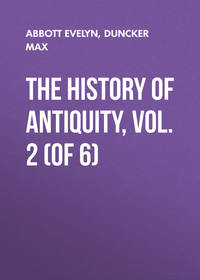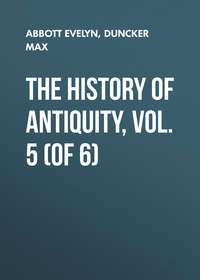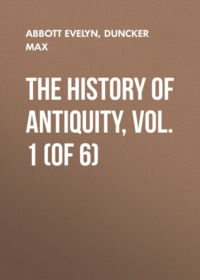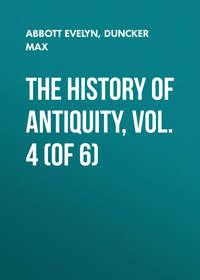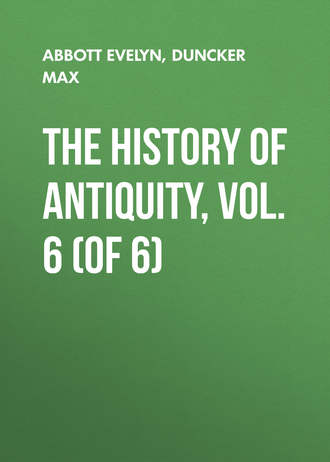 полная версия
полная версияThe History of Antiquity, Vol. 6 (of 6)
Darius thus received every year from the land-tax of the provinces, 7600 talents of silver in the royal standard, i. e. in round figures £2,500,000. To this has to be added the large amount of gold-dust, which the twentieth, or Indian satrapy, paid yearly to the king. This amount, 360 talents according to Herodotus, was not the land-tax of the province; it was obtained from the gold-sands of the Himalayas. This raised the net income of the treasury to a total of about £3,000,000, and to this again have to be added the taxes imposed on Lemnos and Imbros, on the Thracians and the Greek towns on the Thracian coast, with the Macedonians, after the campaign to the Danube, and the tribute in kind paid by the subject tribes among the Arabians (1000 talents of frankincense every year), and the negroes (ivory and ebony), and the tribute in slaves paid by the Colchians (100 boys and 100 virgins every fifth year).
More important than these contributions of the Arabians, negroes, and Colchians, was the income in money which the crown derived from local sources, within the empire, and the proceeds of royal privileges – more important still the produce in kind which the provinces had to pay every year in addition to the land-tax. In the satrapy of the Parthians and Areians a large sum was paid every year for the opening of the sluices of the Ares (no doubt an affluent of the Margus, V. 9), without which the fields were in that district dried up in the summer. In Egypt the fishery on the canal, which connected the lake of Amenemhat with the Nile, brought the king every year 240 talents.374 In what way the contributions in kind were divided and imposed upon the provinces, it is not easy to see. Herodotus only tells us that the whole kingdom was divided into cantons for the support of the king and army; a full third of this burden fell upon the satrapy of Babylon.375 We know that Cappadocia, i. e. Phrygia and Cappadocia, the third satrapy of Herodotus, provided each year, in addition to the land-tax of £103,000, 1500 horses, 2000 mules, and 50,000 sheep; Media in addition to her land-tax provided double this amount of animals.376 Armenia provided 10,000 foals each year in addition to the tax of £115,000.377 Cilicia furnished 360 grey horses each year. Besides these contributions in animals, there were payments in corn for the garrisons in the provinces. The Persians who formed the garrison of the White Fortress in Memphis received yearly from Egypt 120,000 bushels of wheat, an amount which would abundantly supply the wants of 8000 men. As wheat was cheap in Egypt this contribution would represent a value of about £8500.378 Each province sent its best products to the court; and nothing but the best was brought to court or received there; there all that was splendid in the empire was to be collected.379 Babylon sent every year 500 eunuch-boys for service at the court, and Colchis sent male and female slaves of Caucasian race. Chalybon (Helbon) in Syria furnished wine for the court; wheat came from the cities of the Aeolians and the Anatolian coast, salt from the Libyans and the oasis of Siwah.380
"From ancient times," Theopompus of Chios informs us, "the taxes and the entertainment of the king were imposed on the cities according to their size."381 Ctesias and Deinon maintain that the table of the king of Persia, i. e. the entertainment of the entire court, cost 400 talents daily. This is grossly exaggerated. From Herodotus we see that the support of Xerxes and his train, the officers, and all the necessary accompaniments, the tents and plate, and moreover the feeding of the entire army for one day cost the city of Abdera 300 talents, and the island of Thasos 400 talents (£85,000). Theopompus also tells us that when the king visited a city it cost them 20, and sometimes 30, talents to entertain him, and others spent even larger sums.382 These expenses were increased by the fact that the servants took away with them the plate used at table.383 The support of the king, and apparently of the satraps, officers, and generals when travelling, the maintenance of troops on the march, were extraordinary burdens, but the contributions for the table of the king were ordinary and regular. The daily maintenance of the court was expensive, because it included the support of a body-guard. "Every day," Heraclides of Cyme relates, "a thousand animals were slaughtered; among them horses, camels, oxen, asses, and deer, but chiefly sheep. Many birds were eaten, and Arabian ostriches among them. The greater part of this and of the other food was brought to court for the body-guard, and the overseers gave out meat and bread in equal portions; for as the mercenaries in Hellas receive money, so do these soldiers receive their maintenance from the king."384 Fifteen thousand men are said to have been fed at the court every day; and as the body-guard may be put at 10,000 men, this statement does not seem exaggerated.
Beside the contributions in kind for the equipment of the army, the support of garrisons and the court, there were burdens of another kind. The kings of Persia kept great studs for the court and army. We have already mentioned the stud in Nisaea in Media; 150,000 or 160,000 horses are said to have pastured there. The royal studs in Babylonia contained in breeding horses, 800 horses and 16,000 mares – "besides the horses for war," as Herodotus expressly adds. The Indian dogs which were kept by Darius or his successors were so numerous, that four great villages in Babylonia had to contribute exclusively to their maintenance.385 As Herodotus observes that these villages were free from other burdens, we may assume that all the places, on which contributions in kind were imposed for special objects, were exempted from the large contributions for the court and army in horses, beasts of burden, cattle for slaughter, corn, etc. Elsewhere we find places burdened with special services to members of the royal house, or favourites. Certain districts and cities had to pay for the girdle of the queen, others for her veil; one place paid for the head-band, another for the necklace, a third for the hair ornaments of the queen.386 Xenophon tells us that the favourites of the king of Persia received horses and servants in the various provinces, and transmitted them to their descendants.387 When Demaratus, king of Sparta, after losing his throne, sought protection with Darius in Persia, the city of Halisarna and the district of Teuthrania were allotted to him. Gongylus of Eretria received from Darius Gambrium, Myrina, and Gryneum. At a later time Magnesia on the Maeander was assigned to Themistocles – a city, which, recovering from the destruction by Mazares (p. 54), paid, according to Thucydides, a yearly contribution of 50 talents (more than £10,000) for bread, Lampsacus, which was famous for its cultivation of the vine, for wine, and Myus for relishes. In this way, in accordance with the system of Cyrus and Darius, Demaratus was made prince of Halisarna, Gongylus became prince of Gambrium, Themistocles prince of Magnesia; the latter also received contributions in produce from other cities. Demaratus and Gongylus left their thrones to their descendants.388 As the places which had to provide contributions in kind for special purposes or individuals were freed from the contributions of the provinces to the army and court – the land-tax of the places presented to favoured persons were no doubt taken out of the land-tax of the province.
We are not in a position to fix even approximately the amount of the net income of the treasury of Darius which came in every year over and above the land-tax of the provinces and the tolls. Nor can we say how high the yearly contributions in kind paid by the provinces for the court and army ran. If we set aside the extraordinary burdens of supporting the king on a journey, or a satrap, or officer, and the maintenance of troops on a march, and follow Theopompus in assuming that the average daily expense of the whole court amounted to 30 Babylonian talents, a total of 11,000 talents of the royal standard, i. e. more than £3,000,000, would be required for this purpose, a sum in excess of the land-tax of the provinces. If we further assume that the maintenance of the army imposed on the provinces a burden equal to the maintenance of the court, the provinces would have to pay for the state, in ordinary burdens, without regard to their own requirements, three times the amount of the land-tax. Egypt, which, with Cyrene and Barca, had to pay 700 talents in tax, would thus pay 2100 talents of royal money every year, i. e. more than £600,000. At a later time we find that Ptolemy II. received each year from Egypt 14,800 Attic talents, i. e. about £3,000,000, and 1,500,000 artabès of corn, and Ptolemy Auletes received 6000, and, according to Cicero's statement, 12,500 Attic talents.389 The income of the empire of the Sassanids under Chosru Parviz is put at nearly £14,000,000.390
Thus the burdens which the subject lands had to pay to the king do not seem extraordinarily heavy, and, on the other hand, the rule of the Persians certainly tended to promote their welfare. We have observed that the satraps were commanded to take care for the agriculture and the forests of their provinces, and that special attention was paid to this in the visitation of the provinces. In his palaces and wherever he went the king caused the most beautiful gardens to be made and planted with excellent trees,391 and the satraps did the same at their residences. The parks at the residence of the satrap of Phrygia-Cappadocia, near Dascyleum, were of great extent, consisting in part of an enclosure for game, in part of open hunting-ground. When Agesilaus of Sparta had laid them waste, the satrap Pharnabazus said to him: "All that my father left to me, beautiful buildings, gardens full of trees and game, which were the delight of my heart, I now see cut down and burnt."392 At Sardis the satraps of Lydia-Mysia had made several parks of this kind; the most beautiful was adorned with water and meadows, with places for recreation and shade, in a most extraordinary and royal manner.393 The younger Cyrus enlarged this by a new park. When he showed it to Lysander, the Greek marvelled at the beauty of the trees, the evenness of their growth, the straight rows and well-chosen angles in which they stood and cut each other, the various and delightful odours which met those who walked in it, and declared that he admired yet more the man who had measured out and arranged the whole. The prince replied that he had measured it out and arranged it himself, and had even planted some with his own hands. And when Lysander, looking at the splendid clothes of the prince, his chains and amulets and ornaments and perfumes, seemed to doubt this, Cyrus replied: "I swear by Mithra, that I never take food till I have heated myself into a sweat by martial exercises or garden work."394
The trade of the empire must have been very greatly promoted by the roads which Darius made through it in every direction. Merchandise passed from one end of the empire to another on paved roads, which were provided with excellent inns and secured by numerous guard-posts. Moreover, by his royal currency, Darius had created money which passed from the Hellespont and the Nile to the Indus, and thus the merchants had everywhere at hand a fixed measure of value. The raw products which were required by the manufacturing lands, could be bartered in safety, on the upper Nile, in Libya and Arabia, and on the Indus; the wide market which the extent of the Persian kingdom opened to the harbour cities of Asia Minor and Syria, to the industry of the Lydians and Phenicians, the Egyptians and Babylonians, could be used in the readiest and most profitable manner. Ramses II. of Egypt had conceived the idea of a direct communication by water between the Nile and the Red Sea in order to facilitate the trade with South Arabia. For this object he had caused a canal to be taken from the Nile at Bubastis, but he had only carried it as far as the Lake of Crocodiles. Pharaoh Necho more than 700 years later had again taken up the work and carried the canal as far as the Bitter Lakes. From this point the canal was to abandon the direction towards the east and turn almost at a right angle to the south and the Red Sea. Necho failed to effect the communication between the Bitter Lakes and the Red Sea; and the canal remained unfinished. Herodotus, who knew nothing of the attempt of Ramses II., says: "Darius carried a canal from the Nile to the Arabian Gulf."395 "Necho was the first to attempt a canal leading into the Red Sea, and Darius accomplished what he began. The length of the voyage is four days, and the canal is broad enough to allow two triremes when rowing to pass one another (i. e. more than 100 feet). The water of the Nile flows into it a little above Bubastis, and empties into the Red Sea. For the first part it is excavated in the plain of Egypt, which lies towards Arabia, under the mountains opposite Memphis, in which are the stone quarries. At the foot of the mountain the canal runs away to the east, and then through a cleft in the range to the south, and southward, into the Arabian Gulf. The distance from the northern sea – the Mediterranean – to the Red Sea by the shortest route from Pelusium396 is 1000 stades (105 miles); but the canal is much longer, owing to bends in it."397 In the bed of this canal, the direction of which can still be traced in part, three stones were discovered at Saluf El Terraba, on the Crocodile Lake, not far from the southern ridge of the Bitter Lakes. They have recently been much injured by the workmen at the Suez canal. On the front is seen the form of Darius with the tall tiara on his head (the upper part of one of the monuments is preserved); and beside the figure of the king we find the name and title in hieroglyphics. Beneath are the titles and inscriptions in Persian, Turanian, and Babylonian; on the back is an inscription in hieroglyphics which has been destroyed with the exception of a word; but of the Persian and Turanian version we can still read a part: "Darius, the great king, the king of kings, the king of the lands, the king of this wide earth, the son of Hystaspes, the Achæmenid. Darius the king says: 'I, the Persian, have governed Egypt; I have caused a canal to be dug from the river which flows in Egypt to the sea which reaches to Persia.'" Darius did not, like Ramses and Necho, think only of a direct communication by water with South Arabia, but rather of a communication with Persia, and not only with the coasts of Persia but even with the mouths of the Indus. His expedition to explore the Indus did not sail back to the Persian Gulf, but coasted Arabia and returned to the Red Sea; and Herodotus tells us that Darius, after that expedition, made use of the southern sea.398 After opening a road by water into the Red Sea, Darius could, if he thought fit, order the ships of the Ionians and Phenicians to the coast of Arabia, the Persian Gulf, or the Indus, and send the ships of Babylon to the Mediterranean. Traders made a constant use of the canal; the ships of Sidon and Tyre could sail from the Nile to the shores of Arabia Felix, a voyage which the Phenicians at the time of Solomon, and Uzziah of Judah, attempted to make from Elath with the permission and assistance of those princes. From Arabia they could visit the mouth of the Indus, as their ships had done nearly 500 years before at the time of Solomon.
However active the wearer of the crown and his immediate supporters might be in the government of the kingdom, however speedily their commands were made known in the provinces – in spite of the severity with which the satraps were watched and controlled, and the impulse given to their ambition and emulation, – in spite of the excellent management of the state income and the abundance of the means at disposal, and the sums of gold and silver, the gold and silver ornaments, the splendid furniture in the royal citadels, which were in existence for nearly 200 years after this time, attest the success of Darius – the kingdom rested in the last resort on the fidelity and bravery of the army. In his body-guards and in the garrisons of the fortresses and guard-posts scattered up and down the whole kingdom, Darius had a considerable standing army formed of Persians.399 In case of war this standing army was strengthened by the levy of the larger landed proprietors in Persia, who had to furnish cavalry, and the subject lands.400 Though the fortified places were numerous, the amount of troops in the various forts was not necessarily great, and the complement of a Persian battalion, 1000 men, seems rarely to have been exceeded. The garrison of the oldest city in the empire, the White Fortress at Memphis, was much stronger, and so, no doubt, were the garrisons of the two citadels of Babylon and of Ecbatana. In the west Dascyleum on the Propontis, and Sardis, the citadel of which was held by 1000 men, were the extreme points; in the interior there were so many garrisons at Celaenae, on the bridge over the Halys, and at other places west of the Halys, that a considerable army could be formed for service in the field.401 East of the Halys, in Cilicia, there was the garrison of the two forts on the borders of Cilicia and Cappadocia, and in addition a body of cavalry which it cost 140 talents (£40,000) a year to support. The citadels and fortresses which the inscriptions of Darius mention in Armenia, Media, Persia, and Arachosia, show that there was a certain number of fortified places in those regions. In Armenia Tigra and Uhyama are mentioned; in Media Ecbatana and Çikathauvatis; in Arachosia Kapisakanis (Kapisa) and Arsada. The chief points in the royal road from Susa to Sardis at the most important divisions in the country were closed by fortresses, and the same was the case on the other military roads; we cannot therefore doubt that the military arrangements in the eastern provinces were the same as in the west, though the Greeks can only tell us of the west. Lastly, there was a number of fortresses at the extreme borders of the kingdom. In Egypt, in addition to Memphis, Daphne and Elephantine were fortified;402 in the country of the Cadusians Cyrus had already founded the city on the Jaxartes known as Ultima Cyrus, and in the neighbourhood were several citadels to protect the borders (p. 103). Besides the garrisons, the amount of troops was fixed which the satraps had to keep under arms, to support their authority, to carry out executions, and to secure the provinces.403 Like the garrisons, the troops of the satraps, in case of necessity, could fall back on the assistance of the reserve corps of larger districts, such as the Cilician cavalry. The troops stationed in the provinces were reviewed yearly, as Xenophon tells us. For this object they were gathered together at a fixed place in the provinces, with the exception of the garrisons of the fortresses. For the more western districts the place of assembly was Thymbrara on the Pactolus,404 where also, in time of war, the levy of the province was assembled. The troops which were nearer the residence of the king, were, according to Xenophon, inspected by the king in person; those at a greater distance by men in his confidence. The satraps, chiliarchs, and commandants, who brought up the prescribed number of troops provided with excellent weapons and horses, were rewarded by presents and marks of distinction; those who neglected their troops or made money out of them were severely punished and removed from their office.405
From Herodotus we learn that the guard of the king consisted of 2000 selected Persian horsemen and 2000 lance-bearers on foot, whose lances were adorned at the lower end with apples of gold and silver, and also of a division of 10,000 infantry, whom the Persians call the immortals, because their number is always the same. But the name of the corps may be formed from the Amesha Çpenta Ameretat (V. 156, 164). Xenophon ascribes this institution to Cyrus.406 Nine thousand of them had silver pomegranates on their lances, but a thousand who were selected from the whole corps to form the first battalion had their pomegranates of gold. On the monuments they carry lances taller than the height of a man, and oval shields of half a man's height. This troop was distinguished as the body-guard of the king by golden necklaces and other ornaments; it was better furnished than other troops with beasts of burden and camels to carry the baggage and the provisions. Later writers speak only of these 10,000 infantry as forming the guard. They inform us that the corps was always about the king, keeping watch in the palace day and night, where they had a court to themselves; they accompanied the king on his journeys, when they camped in a circle round the king's tent.407 The amount of the whole army cannot even be approximately fixed. Darius led the levy of the empire over the Bosphorus to the amount of 700,000 men; from the subject lands so many soldiers would be required as would be necessary.408 It was more difficult to organize this vast mass. The strength of the army, like that of the kingdom, rested on the military skill and superiority of the Persians. With the Persians, as with the Indians, the chief weapon was the bow, and the Persian arrows like the Indian were of reed. Aeschylus praises "the mighty with the bow, the strength of the Persian land," and Atossa, the queen of Darius, is represented as asking whether "the bow-driven arrow adorns the hand" of the Hellenes.409 The Persians preferred to fight on horseback. The rider placed a coat of mail over the short shirt, and beside the bow and a short javelin carried a crooked and not very long sabre on the right hip;410 the head was protected by the tiara. But there were also large divisions of heavy armed cavalry among the troops of the Persians in which the men wore brass or iron helmets and strong harness, while their horses were armed with frontlets and breast-pieces.411 The infantry carried long rectangular shields of wicker-work, under which hung the quiver with the javelin and sabre, but as a rule they were without coats of mail.412 The leading men and officers were adorned in battle with their best purple robes, neck-chains, and armlets; over the coat of mail they threw the glittering kandys; on the hip hung a sabre with a golden handle and a golden sheath. Thus they mounted their war-horses, Nisaean greys, with golden trappings, the wildness of which sometimes caused the death of the rider. Aeschylus speaks of them as "horsemen mighty with the bow, dreadful to behold, and terrible in the venturous courage of their hearts."413 In military skill the Persians regarded the Medes as next to themselves; then followed the Sacae, the Bactrians, the Indians, and the other Arian tribes. Next to the Medes the Sacae were the most trustworthy troops.414 The contingents of the provinces were governed by Persian generals, who were mainly taken from the members of the royal family, the "kinsmen" of the king, and the tribal princes.415 Like the Persian troops, these contingents were arranged in divisions of 10,000 men. Each division was subdivided into ten battalions of 1000 men, and the battalions into ten companies of 100 men; the company was made up of groups, which, according to Xenophon, consisted of seven men among the Persians, and according to Herodotus of ten in the contingents.416 The commander of the entire contingent of a province had the nomination of the officers of divisions and the leaders of battalions; the officers of divisions, as Herodotus says, nominated the captains of companies, and the leaders of the groups.417 The native dynasts as a rule marched out with their troops and ships, but they were subject to the commanders of the contingents.418
The king reviewed the army from his war-chariot, surrounded by scribes, who wrote down everything worthy of notice. When parading before the king, the horsemen dismounted, stood by their horses, and concealed their hands in the sleeves of their kandys. The camp was always pitched in a particular order; the tent of the king was on the eastern side, for the abode of the gods was in the east. The large and splendid tent of the king was surrounded by the tents of the guard; the cavalry, the infantry, and the baggage had special places assigned to them.419 They understood how to fortify the camp;420 an open camp was always at a certain distance, about seven miles, from the enemy in order to avoid surprises as far as possible. The Persian cavalry required a considerable time, especially at night, for preparation. Their spirited horses had not only to be tethered, but even tied by the feet to prevent their running away. The unfettering, saddling and bridling of the horses, and putting on the harness, took up much time, and could not be done at night without disorder and confusion.421 When there was danger of a surprise the troops had to remain at night under arms. The signal for marching was given from the royal tent with the trumpet, but never before daybreak,422 "before the glittering Mithra mounted, and in golden shape seized the beautiful summits," the army of the Persians was not to move. In the same way the march ended at the latest at sunset.423 In battle the king occupied the centre of the position, surrounded by the Achæmenids, the "kinsmen" and "companions," several hundred in number,424 and the body-guard, the cavalry of which usually stood in the first ranks before the king; next to them in the centre came the best troops in the army.425 According to ancient custom the king generally fought from a chariot drawn by Nisaean horses,426 with his bow in his hand, in which manner, at an earlier period, the princes of the Indians had fought, and the kings of the east, the Pharaohs, the rulers of Assyria, and the princes of the Syrians. The king also, when in battle, wore all his royal ornaments, the purple kaftan over his armour, and the royal tiara. Near him was the ensign of the empire, the golden eagle on a tall pole.427 The mass of the cavalry was generally placed on the wings; between these and the centre were the contingents of the subject nations, each according to its divisions, which were drawn up separately in solid squares.428 The battle was begun by the cavalry and infantry with a thick shower of arrows. With this an attempt was made to ward off the attacks of the enemy, and it was kept up till the enemy seemed to be thrown into confusion. Then the troops were brought closer; javelins were hurled and sabres drawn.429 The Persian and Sacian cavalry was most dreaded; as it consisted to a great extent of archers it was difficult to approach it. If the cavalry marched to the attack with arms in rest, the onset was made first with separate squadrons, and then in entire masses.430 The Medes and Persians had learned the art of siege from the Assyrians. The cities were enclosed by ramparts, and on these works were carried forward, under the protection of which battering-rams were brought to bear against the trenches and walls. The Persians were also well acquainted with mining. Passages were carried under-ground, both to make breaches in the walls by excavations, and to provide a way into the city. In order to recapture Chalcedon, which had rebelled against Darius when he crossed the Danube against the Scythians, together with the cities of the Propontis and Hellespont, an under-ground passage of more than 15 stades in length was carried, after the king's return, under the walls of the city to the market-place, and the Chalcedonians had no suspicion of its existence, till the Persians appeared in the city.431


